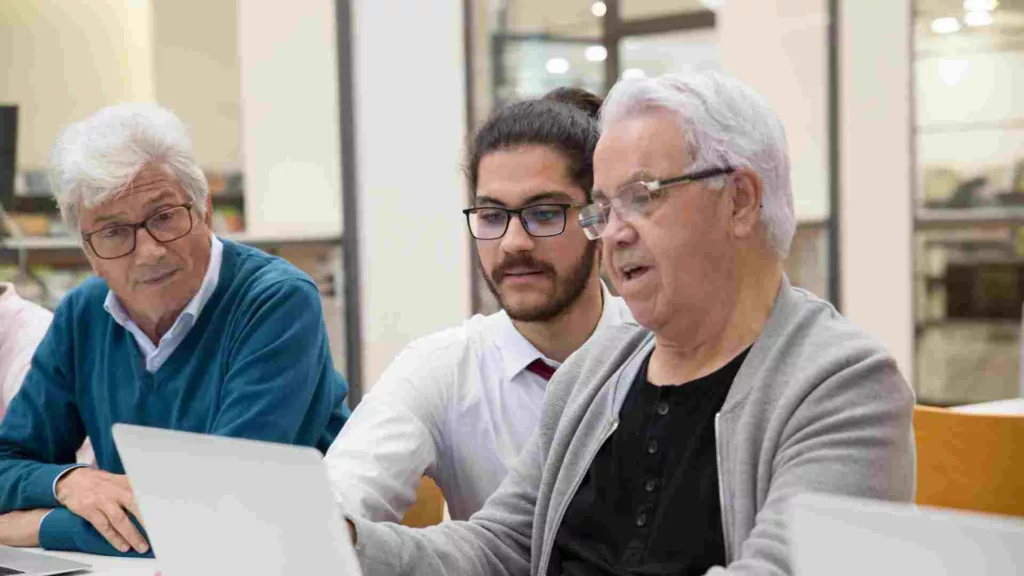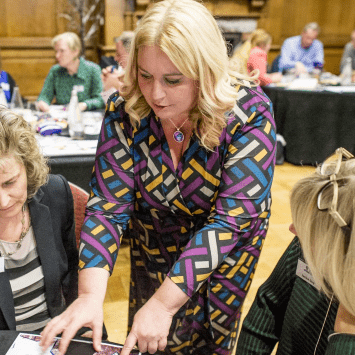Posted in Blog, Facilitation, Innovation Culture, Lead Your Team by Jo North
25 Easy Tips for a Really Collaborative Team Meeting
Being able to successfully lead a collaborative team meeting is an essential skill.
Collaboration is an essential aspect of today’s dynamic workplaces. When teams come together with a shared goal, it fosters a successful collaboration that produces innovative ideas and robust solutions. Collaborative team meetings play a pivotal role in promoting this sense of unity and purpose.
Here are 25 easy tips to ensure you have a really effective, collaborative meeting.

1. Set a Clear Purpose
Before scheduling any meeting, make sure that your team understands the purpose of the meeting. A clear goal prevents unproductive meetings and gives direction.
It’s important to note that every participant should be informed of this purpose well in advance, allowing them to prepare effectively.
Having a defined objective promotes focus and keeps discussions on track, eliminating tangential conversations that can often dominate and derail meetings. Furthermore, a well-articulated purpose encourages participation, as team members understand their roles and contributions in the context of the larger objective.
Recent research in organizational behavior also emphasizes the psychological and business performance impacts of clarity. When individuals are aware of the aim and purpose, they are more likely to be engaged and invested.
Moreover, in today’s digital age where virtual meetings are prevalent, having a defined purpose can combat the “Zoom fatigue” many experience from a deluge of online meetings. It provides a filter, helping discern which meetings are essential and which can be replaced with an email or a collaborative document.
In multi-departmental or cross-functional meetings, a clear purpose ensures that even those with disparate roles or backgrounds have a unified understanding, bridging potential knowledge gaps and promoting a cohesive team approach.
In addition to having a specific purpose for your meeting, show how this purpose aligns to your business’ mission, vision and values.

2. Prepare a Meeting Agenda
To make good use of everyone’s time, have clear agendas. Each agenda item should have a designated time slot to keep the meeting on track.
Delving deeper, a well-constructed agenda acts as a navigational tool for discussions, ensuring that all essential topics are covered while preventing sidetracking into unrelated areas.
When attendees have an agenda in advance, they undergo enhanced cognitive preparation, making them more predisposed to contribute actively in discussions.
Be Mindful of Parkinson’s Law
By assigning specific time slots to each item, the meeting respects Parkinson’s Law’s principle: work expands to fit the time allocated for its completion. In the context of your collaborative team meeting, this means that without determined timeframes, discussions can stretch unnecessarily, trimming the time available for other crucial topics.
Ask for Agenda Item Suggestions in Advance
A lesser-known yet impactful practice in agenda-setting is to solicit suggested agenda items from attendees prior to the meeting. This democratic approach not only ensures all pressing issues are covered but also empowers attendees, fostering a sense of ownership and engagement in the meeting’s outcomes.
Any Other Business (AOB)
Incorporating an “Any Other Business” (AOB) section at the agenda’s conclusion offers a systematic opportunity for participants to introduce unexpected topics or concerns. This level of diligence not only heightens the meeting’s efficiency but also enhances attendee satisfaction and the feeling that the meeting is time well spent.
Avoid ‘Agenda Theater’
Make sure that you combine a great agenda with a well-run meeting, though, to avoid ‘Agenda Theater’. Having a great agenda can feel very productive, but it will only contribute fully if you also focus on how the meeting is run.
3. Encourage Team Members
For successful team collaboration, it’s crucial that all team members participate actively. Encourage open discussion and active listening.
Genuine engagement from every participant forms the cornerstone of effective collaboration. When team members feel their input is valued, they’re more likely to invest time and energy into the collaborative process.
There is a positive relationship between inclusivity in discussions and heightened creativity and problem-solving abilities.
Build Psychological Safety
A less commonly acknowledged, but vital strategy to bolster participation is to create a sense of psychological safety within the team.
“Psychological Safety is a belief that one will not be punished or humiliated for speaking up with ideas, questions, concerns, or mistakes.”
Professor Amy Edmondson, Harvard Business School
This concept, popularized by studies from Google’s Project Aristotle, emphasizes that members should feel secure enough to voice dissenting opinions, ask questions, and make mistakes without fear of retribution. Such an atmosphere cultivates richer discussions, where diverse perspectives converge and lead to innovative solutions.
Round Robin Technique
Additionally, tools such as the “round robin” technique, where each member gets an uninterrupted moment to speak, can be instrumental in ensuring everyone’s voice is heard, especially in larger teams or in settings where some individuals might naturally be more reserved.
Listening
As the team’s dynamics evolve, active listening becomes pivotal, enabling members to understand, empathize, and build upon each other’s ideas. Through fostering this environment, teams not only achieve their immediate goals but also lay the foundation for continued synergy in future collaborations.
4. Use the Right Tools
Best team collaboration tools, like Microsoft Teams, Zoom and Google Meet, offer collaborative features that facilitate real-time information sharing. Whether it’s video conferencing, collaborative notes, or sharing important documents through platforms like Google Drive, the right tools can elevate the collaborative experience.
These tools like the Swiss Army knives of teamwork – packed with features for chatting, video meetings, and sharing files in real-time. Ever had that annoying moment of searching for that one document? Platforms like Google Drive can save you from that hassle, keeping all your files in one easy-to-find spot.
Plus, many of these tools talk to each other, so you can jump from a chat to a project task without missing a beat.
And for those who work with teammates from around the world, some of these tools even translate on the fly or jot down meeting notes for you. A bonus is that they’re big on keeping your chats and files safe from prying eyes.
While it’s great to have these great tools, remember that it’s the teamwork that really counts.

5. Acknowledge Different Skill Sets
Recognize that your team comprises individuals with different skills and perspectives. This diversity can bring about innovative solutions.
Each person brings their own special skill or perspective to the table. When you create a diverse team and mix all these different talents, you get some pretty awesome results. It’s a bit like making a great recipe – everyone adds a different ingredient, and together, it tastes amazing.
Research even shows that diverse teams can come up with cooler solutions than those where everyone thinks the same. Plus, when things get tricky, having different people to lean on means there’s always a fresh way to tackle a problem. So, celebrate everyone’s strengths, share knowledge, and remember that every skill, big or small, makes the team that much stronger and more fun to be a part of.
6. Promote Continuous Learning
As the world changes and technology advances, there’s always something new to learn. For teams to stay ahead of the curve and collaborate effectively, it’s essential to keep learning.
Regular training sessions, workshops, or even team discussions about new industry trends can be beneficial. This doesn’t only mean formal education; sometimes, a team member might come across a new app, a handy shortcut, or a fresh idea that they can share.
By fostering an environment where knowledge sharing is encouraged, teams can continuously innovate, adapt, and tackle challenges more efficiently. This approach not only enhances team collaboration but also ensures that the team remains agile and competitive in a fast-paced business landscape.
7. Document Action Items and Decisions Throughout Your Collaborative Team Meeting
Always end your collaboration meetings with a clear action plan. Note down next steps, assign responsibilities, and set deadlines.
Wrap up your meetings with a game plan everyone understands. Picture it like a to-do list for the team: who’s doing what and by when? It’s all about writing down the important decisions made and the tasks that need to be done next.
And here’s a lesser-known tip: try using a shared online document, like Google Docs, where everyone can see and access the list. This way, everyone’s on the same page (literally!) and can tick off tasks as they complete them. It’s not just about keeping track, but also about celebrating little victories along the way.
Having a clear, visible list means fewer misunderstandings, missed tasks, and last-minute panics. Plus, it feels great to see the team’s progress in real-time!
8. Set and Follow the Ground Rules for Your Collaborative Team Meeting
Setting ground rules can prevent overruns and ensure everyone gets a chance to speak.
Before diving into any collaborative team meeting, it’s smart to lay down some ground rules. Think of them as the “game rules” for your meeting. They help ensure that everyone is heard, the discussion stays on track, and time is used efficiently.
For example, a rule could be as simple as “no interrupting” or “one person speaks at a time.”
But here’s something not everyone thinks about. Sometimes, team members might want to introduce a topic not on the agenda. A good rule for this can be to have a set “question time” at the end or to make a note and come back to it later.
By setting and sticking to some ground rules, everyone knows what’s expected, making for a smoother, more respectful meeting where every voice has the chance to shine.
9. Facilitate Interactive Discusion
Different points of view can lead to a richer, more rounded solution. Encourage interactive discussion and active participation.
During a collaborative team meeting, it’s like putting together a puzzle – everyone has a piece to add. When people share different views and ideas, the picture gets clearer and more complete.
To really get the most out of these discussions, it’s a good idea to create a space where everyone feels comfortable speaking up. This might mean using icebreakers at the start or setting a rule where everyone shares a thought on the topic. And remember, listening is just as important as speaking. So, encourage team members to really hear each other out. Sometimes, the quietest person in the room might have a game-changing idea.
By promoting this interactive atmosphere, not only do you get more ideas on the table, but everyone feels more invested in the final decision, making the whole team stronger and more united.

10. Foster Inclusivity and Belonging
One of the most important aspects of collaborative team meetings is creating an environment where everyone feels they belong and can contribute without hesitation.
A truly inclusive environment recognizes and values the unique experiences and perspectives each person brings. Whether it’s someone from a different cultural background, someone with a physical disability, or someone who thinks differently, their viewpoints can add untold depth and innovation to a project. By fostering inclusivity, you ensure everyone is comfortable sharing their insights, leading to richer discussions and better outcomes.
Activities like diversity and inclusion training can be beneficial, as can simple actions like ensuring meeting times are suitable for all, using inclusive language, and being mindful of different cultural practices and holidays. It’s not just about being fair – it’s about leveraging the full power of every team member to achieve superior results.
11. Prioritize Effective Communication
Clear communication prevents misunderstandings. Use visual aids, collaborative meeting notes, and encourage questions.
In a collaborative team meeting, the ability to convey ideas clearly and understand others is key to success.Misunderstandings can lead to wasted time, errors, and even unnecessary conflicts. To combat this, it’s essential to prioritize effective communication.
Start by using visual aids like charts, graphs, or slides which can make complex ideas easier to grasp.
Taking collaborative meeting notes ensures everyone stays on the same page. Platforms like Google Docs can allow real-time contributions from all participants, creating a shared understanding of the discussion.
Additionally, always encourage team members to ask questions. Not only does this clarify any uncertainties, but it can also spark deeper conversations and insights. When everyone feels comfortable speaking up and knows they’ll be understood, meetings become far more productive and successful.
12. Respect Different Departments
In larger organizations, different teams or departments might have unique use cases or priorities. Understanding these can lead to more holistic solutions.
In any sizable organization, each department or team often functions like its own mini ecosystem, each with its specific goals, challenges, and ways of operating. When organizing a collaborative team meeting that involves multiple departments, it’s crucial to respect and understand these differences.
By taking the time to learn about the unique use cases or priorities of each department, you pave the way for a more inclusive conversation. This doesn’t just mean acknowledging their distinct roles but genuinely understanding the nuances of their daily operations and concerns. Doing so allows for the creation of more holistic solutions that consider the organization’s broader picture and cater to its diverse needs.
When all departments feel heard and valued, collaboration becomes smoother, more effective, and yields better results for everyone involved.
13. Be a Great Meeting Facilitator
In a collaborative team meeting, a great facilitator sets the tone, ensuring everyone feels comfortable sharing their ideas and opinions.
Being an effective meeting facilitator is much more than just guiding a discussion. A great facilitator reads the room, noticing when someone might be hesitant to speak up and providing them the opportunity to voice their thoughts.
It’s also their responsibility to manage time wisely, making sure the meeting stays on track and all agenda items are covered. Moreover, they handle disruptions gracefully, ensuring that discussions remain productive and respectful.
Lesser known is the facilitator’s role in fostering a positive after-meeting experience. They ensure that meeting takeaways are clear, follow-up actions are designated, and that there’s a plan for revisiting unresolved issues. By mastering these skills, by being a great facilitator, you can turn every collaborative team meeting into an engaging and productive experience.
14. Optimize Your Collaborative Team Meeting for Large Groups
For large teams, use breakout sessions or group discussions to ensure everyone’s voice is heard.
When it comes to your collaborative team meeting with a large number of participants, things can easily get either super dull and hard work (quiet groups) OR chaotic (talkative groups) if you don’t manage it well.
It’s essential to ensure that everyone, regardless of their role or seniority, has an opportunity to contribute.
One effective strategy is to use breakout sessions, where the main group divides into smaller teams to discuss specific topics or challenges. These smaller groups can foster more intimate discussions, allowing members who might be quieter in larger settings to share their insights.
After the breakout sessions, teams can then regroup and share their findings with everyone.
Another approach is to facilitate structured group discussions, where individuals are given a set time to share their thoughts or updates. This ensures that the discussion remains organized and that everyone’s perspective is considered, making the collaborative meeting more inclusive and comprehensive.

15. Avoid Information Overload
Be concise. While it’s a great idea to share, too much information can be overwhelming.
During a collaborative team meeting, it’s tempting to share every detail or dive deep into the minutiae, but this can lead to participants feeling swamped or losing focus.
Information overload can make it hard for team members to discern key points or prioritize tasks.
Instead, aim to present information in a clear and straightforward manner. Use summaries, bullet points, and visuals like charts or graphs to convey essential information.
If there’s additional data that needs to be shared, consider distributing it as a handout or via email for team members to review at their own pace. This approach ensures everyone stays engaged during the meeting and can easily grasp the main takeaways.
16. Encourage Regular Check-ins Outside Your Collaborative Team Meeting
Even outside of formal collaborative team meetings, it’s essential to keep the momentum going.
Encourage team members to check in regularly with each other, providing updates on their progress or seeking feedback on specific tasks. These check-ins can be brief and conducted through various means, such as quick chat messages, emails, or short calls. Regular touchpoints not only foster a sense of unity and collaboration but also ensure that potential challenges are identified and addressed early, keeping projects on track and fostering a dynamic team environment.
17. The ‘Parking Lot’ Method
If a non-urgent, key issue arises that isn’t on the agenda, place it in a ‘parking lot’ to address in the next meeting.
During a collaborative team meeting, it’s not uncommon for relevant but non-urgent topics to pop up. While these subjects might be essential, addressing them immediately can derail the focus of the current discussion. The ‘Parking Lot’ method is a smart way to handle this.
By designating a space, whether it’s a section on a whiteboard or a page in a notebook, for these “parked” topics, you ensure they don’t get overlooked.
After the meeting, these items can be reviewed, prioritized, and added to the agenda for future discussions. It keeps the meeting on track while also respecting the input and concerns of all participants.
18. Incorporate Team Building Activities
Introducing team building exercises into your collaborative team meetings can help break the ice, particularly if the group isn’t well-acquainted.
These activities can range from simple ice-breakers and energizer activities to more involved team challenges.
The goal is to build rapport, enhance communication, and strengthen the bonds between team members. When teams understand and appreciate each other’s strengths and quirks, they’re more likely to collaborate effectively and approach challenges with a unified mindset.
Plus, a bit of fun can re-energize a meeting and make the collaborative process more enjoyable.

19. Rotate Leadership of Your Collaborative Team Meeting
Switch up who leads the collaborative team meeting each time. This approach gives everyone a chance to develop leadership skills and ensures a fresh perspective in guiding the discussion, fostering a sense of ownership and engagement among all members.
In a collaborative team meeting, it’s important to keep things dynamic and inclusive. By rotating meeting leadership, teams can tap into the diverse experiences and viewpoints of each member.
Not only does this break the monotony, but it also empowers individuals, making them feel valued and boosting their confidence.
It’s a lesser-known fact that when people take on leadership roles, even temporarily, they tend to be more invested and accountable for the outcomes. Plus, different leadership styles can reveal unique problem-solving approaches or innovative ideas that might have otherwise been overlooked.
This rotation method can be a game-changer, turning every meeting into an opportunity for growth and fresh insights.
20. Emphasize the Benefits of Team Collaboration
Regularly remind team members of the benefits of collaborative meetings, such as faster problem-solving or improved project management.
During a collaborative team meeting, it’s easy for participants to get caught up in the details and forget the broader benefits of working together. However, by consistently emphasizing the advantages of team collaboration, everyone can remain focused on the bigger picture.
Beyond the obvious perks like faster problem-solving and enhanced project management, collaboration brings lesser-known benefits. For instance, when teams collaborate, there’s a shared sense of ownership and responsibility that boosts morale and motivation.
Moreover, diverse perspectives can lead to creative solutions that might be overlooked by an individual. And there’s the added bonus of shared learning. As team members interact, they often exchange knowledge and skills, which can be invaluable in future tasks.
By highlighting these benefits during a collaborative team meeting, it’s easier to maintain enthusiasm and commitment to the collaborative process.

21. For Hybrid Meetings, Put Practicality Front and Center
When organizing a collaborative team meeting for hybrid teams, practicality should be front and center. The solutions you choose need to be more than just functional; they should be easy for everyone, whether they’re in the office or joining remotely.
A great hybrid team meeting means selecting tools and platforms that are user-friendly, reliable, and versatile. For instance, can participants easily share their screen or co-edit a document in real-time? Is there a straightforward way for members to indicate they have a point to make without interrupting the speaker?
Consider potential technical glitches, like connectivity issues or software incompatibilities, and have backup solutions ready. It’s also wise to account for different time zones, ensuring that no one is always stuck with inconvenient meeting times.
And remember, a quick training or refresher on the tools being used can go a long way in ensuring smooth operations.
When everyone can participate without technical barriers, your hybrid team meetings will be more efficient and productive.
22. Encourage Constructive Challenge
In a collaborative environment, it’s essential to create a safe space where team members feel empowered to voice disagreements or alternative viewpoints.
While it’s crucial to maintain respect, encouraging constructive challenges can lead to more thorough discussions and well-rounded solutions. By questioning the status quo and pushing boundaries, teams can innovate and make more informed decisions.
During a collaborative team meeting, creating an environment where participants feel motivated to express differing opinions is paramount to achieving optimal results. It isn’t solely about permitting dissent; it’s about valuing and actively soliciting varied insights.
Championing this dynamic aids in pinpointing possible oversights in a strategy and unveils innovative solutions that might remain obscured in a less inclusive setting.
Central to this ethos is the role modeling of a growth mindset by leadership. By showcasing a willingness to learn, adapt, and embrace challenges, leaders can instill a culture where challenges are not just accepted but are welcomed as opportunities for growth and development.
By emphasizing every team member’s importance and ensuring that challenges are approached with curiosity rather than defensiveness, meetings can evolve from mere discussions into powerful brainstorming sessions, harnessing the group’s collective wisdom.

23. Collect Feedback on Your Collaborative Team Meeting
After the meeting, ask for feedback. Continuous improvement is the key to successful collaboration.
When wrapping up a collaborative team meeting, one often overlooked yet vital step is the collection of feedback. This isn’t merely about gauging the effectiveness of a single session but rather understanding the evolving needs and preferences of the participants.
Whether it’s the meeting’s duration, the clarity of the points discussed, or the tools employed, every element can impact the meeting’s success. By actively seeking feedback, not only do leaders demonstrate a commitment to everyone’s experience, but they also gather insights that can be instrumental in refining future sessions.
The most effective meetings are those that evolve based on the collective input of its members. Moreover, in a world of ever-changing technology and methodologies, staying adaptable and open to new suggestions can transform a good collaborative environment into a great one.
Remember, it’s often the smallest adjustments, brought to light by candid feedback, that make the most significant impact on a team’s collaborative endeavors.
24. Celebrate Collaborative Successes
When a group of people achieves a milestone due to their collaborative efforts, celebrate! It fosters employee engagement and sets a positive precedent.
Celebrating collaborative successes goes beyond mere acknowledgment; it’s an opportunity to reinforce the team’s cohesiveness and the importance of every member’s contribution.
In any collaborative team meeting, taking a moment to highlight achievements, both big and small, underscores the value of collective effort.
Consider implementing creative ways to celebrate: host a virtual applause session, send out personalized ‘thank you’ notes, or even organize a team lunch or treat delivery for remote members.
Sharing success stories in company newsletters or on social media platforms can also amplify the recognition.
Creating a “Wall of Fame” in the office or a digital equivalent can serve as a lasting testament to the team’s accomplishments.
These celebrations not only bolster morale but also help to build a deeper connection among team members, encouraging them to strive for more collaborative victories in the future.

25. Use an Expert, Independent Facilitator for Your Significant, Collaborative Team Meeting
Having a trained, independent facilitator can be a game-changer for significant, important team meetings.
Facilitation professionals come equipped with the skills and experience to manage group dynamics, ensure that everyone has an opportunity to contribute, and drive discussions towards concrete outcomes.
In a collaborative team meeting, it’s essential that the focus remains on the agenda, free from internal biases or team politics. An external facilitator can provide this unbiased perspective, helping to navigate potential roadblocks and fostering an environment where true collaboration thrives.
Moreover, they bring in proven strategies and techniques to enhance engagement, ensuring that the meeting’s goals are not only met but exceeded.
Work with Me and The Big Bang Partnership Team
If you’re looking to elevate your team’s collaborative efforts, especially in critical meetings, consider the expertise of a seasoned facilitator.
Contact me here at The Big Bang Partnership for one-to-one facilitation coaching, team facilitation training or hands-on facilitation of your collaborative team meeting. Together, we can transform your meetings into powerful platforms for actionable insights and innovative solutions.
Wrap Up
Whether you’re a product manager, part of sales teams, or in customer support, the need for effective collaboration is universal. Gone are the days of isolated teams working in a conference room. Today’s collaborative meetings, especially in the age of remote work and diverse teams, require the right approach and tools. With the above tips, you can ensure that every meeting is a step towards a more successful team and organization.


